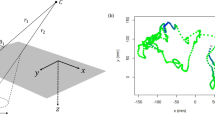Abstract
In many cases, traditional hand-drawn animation has been replaced by computer technology. Computer-supported approaches can essentially be characterised as two interface types: keyframing and coding. However, these two interface types offer limited editing ability for scene animation applications, which usually consist of a large testing space of similar behaviours. The testing cycle, using either predefined keyframe sequences or general coding interface, tends to be costly and time consuming. This paper reports work which uses the DataGlove device to support and test variable schooling behaviours of fish in a virtual marine world. This is put forward as a representative example of scene animation. The glove-based interface places the user as a participant in the behavioural simulation process. In the work, hand shapes and motions are recognised and used for either event triggering or role switching. The specific shapes and motions of the user's hand trigger control signals or commands through a menu-based interface. The hand can itself be used to simulate an object in the scene. The object, which can be either static or dynamic, participates in the control process. Using hand movements in this way allows the user to interactively specify the paths of moving objects in the scene, and also creates a diversity of dynamic situations which can be useful for testing variable scene behaviours. The application presented in this paper looks at examples of controlling fish behaviour in a limited pond environment controlled by glove-based interaction.
Similar content being viewed by others
Explore related subjects
Discover the latest articles, news and stories from top researchers in related subjects.References
Badler, N., Manoochehri, K. and Baraff, D. (1986). Multi-dimensional Input Techniques and Articulated Figure Positioning by Multiple Constraints. In theProceedings of the ACM Workshop on Interative 3-D Graphics 151–169.
Baudel, T. and Beaudouin-Lafon, M. (1993). Charade: Remote Control of Objects Using Free-Hand Gestures.Communications of the ACM 36(7): 28–35.
Brooks, F., Jr., P. (1986). Walkthrough — a Dynamic Graphics System for Simulating Virtual Buildings. In theProceedings of the ACM Workshop on Interactive 3-D Graphics 9–21.
Brooks, F. (1988). Grasping Reality Through Illusion: Interactive Graphics Serving Science. In theProceedings of CHI '88.
Brooks, F., Ouh-Young, M., Batter, J., Kilpatrick, P. (1990). Project GROPE-Haptic Displays for Scientific Visualisation. Computer Graphics24(4): 177–185.
Calvert, T., Welman, C., Gaudet, S., Lee, C. (1989). Composition of Multiple Figure Sequences for Dance and Animation. In theProceedings of Computer Graphics International '89, (New Advances in Computer Graphics) 245–255.
Forsey, D. and Wilhelms, J. (1988). Techniques for Interactive Manipulation of Articulated Bodies Using Dynamic Analysis. In theProceedings of Graphics Interface '88 8–15.
Girard, M. and Maciejewski, A. A. (1985). Computational Modelling for the Computer Animation of Legged Figures.Computer Graphics 19(3): 263–270.
Green, M. (1993). Minimal Reality Toolkit: Programmer's Manual.MR Manual, (Department of Computing Science, University of Alberta).
Hinckley, K., Pausch, R., Goble, J. and Kassell, N. (1994). A Survey of Design Issues in Spatial Input. In theProceedings of UIST '94 213–222.
Hutchins, E., Hollan, J. and Norman, D. (1986). Direct Manipulation Interfaces. In Norman D. A. and Draper S. (eds.)User Centred System Design (Lawrence Erlbaum Associates, Inc.) 87–124.
Lasseter, J. (1987). Principles of Traditional Animation Applied to 3-D Computer Animation.Computer Graphics 21(4): 35–44.
Papper, M. and Gigante, M. (eds.) (1993). Using Gestures to Control a Virtual Arm.Virtual Reality Systems (London: Academic Press).
Reeves, W. T. (1981). Inbetweening for Computer Animation Utilising Moving Point Constraints.Computer Graphics 15(3): 263–269.
Reynolds, C. W. (1982). Computer Animation With Scripts and Actors.Computer Graphics 16(3): 289–296.
Reynolds, C. (1987). Flocks, Herds and Schools: A Distributed Behavioural Model.Computer Graphics 21(4): 25–34.
Shneiderman, B. (1983). Direct Manipulation: A Step Beyond Programming Languages.IEEE Computer 16(8): 57–69.
Sturman, D. (1992). Whole-Hand Input. Doctoral Dissertation (Media Lab, MIT, Cambridge).
Sturman, D. and Zeltzer, D. (1994). A Survey of Glove-based Input.IEEE CG&A 14(1): 30–39.
Su, S., Furuta, R. (1994). A Logical Hand Device in Virtual Environments. In theProceedings VRST'94 33–42.
Sun, H. and Green, M. (1993). The Use of Relations for Motion Control in an Environment with Multiple Moving Objects. In theProceedings of Graphics Interface '93 209–218.
Sun, H. (1994). Hand-guided Scene Modelling. Book Chapter Publication ofVirtual Reality Applications. (London: Academic Press).
Takahashi, T. and Kishino, F. (1991). Hand Gesture Coding Based on Experiments Using a Hand Gesture Interface Device.SIGCHI Bulletin 23(2): 67–74.
Thalmann, D. and Magnenat-Thalmann, N. (1984). CINEMIRA: A 3-D Computer Animation Language Based on Actor and Camera Data Types. Technical Report (University of Montreal).
Tu, X. and Terzopoulos, D. (1994). Artificial Fishes: Physics, Locomotion, Perception, Behaviour. In theProceedings of Computer Graphics '94 43–50.
Wexelblat, A. (1994). Natural Gesture in Virtual Environments. In theProceedings of VRST'94 5–16.
Author information
Authors and Affiliations
Rights and permissions
About this article
Cite this article
Sun, H. A behavioural test-bed using a dataglove input device. Virtual Reality 1, 109–116 (1995). https://doi.org/10.1007/BF02009727
Issue Date:
DOI: https://doi.org/10.1007/BF02009727




